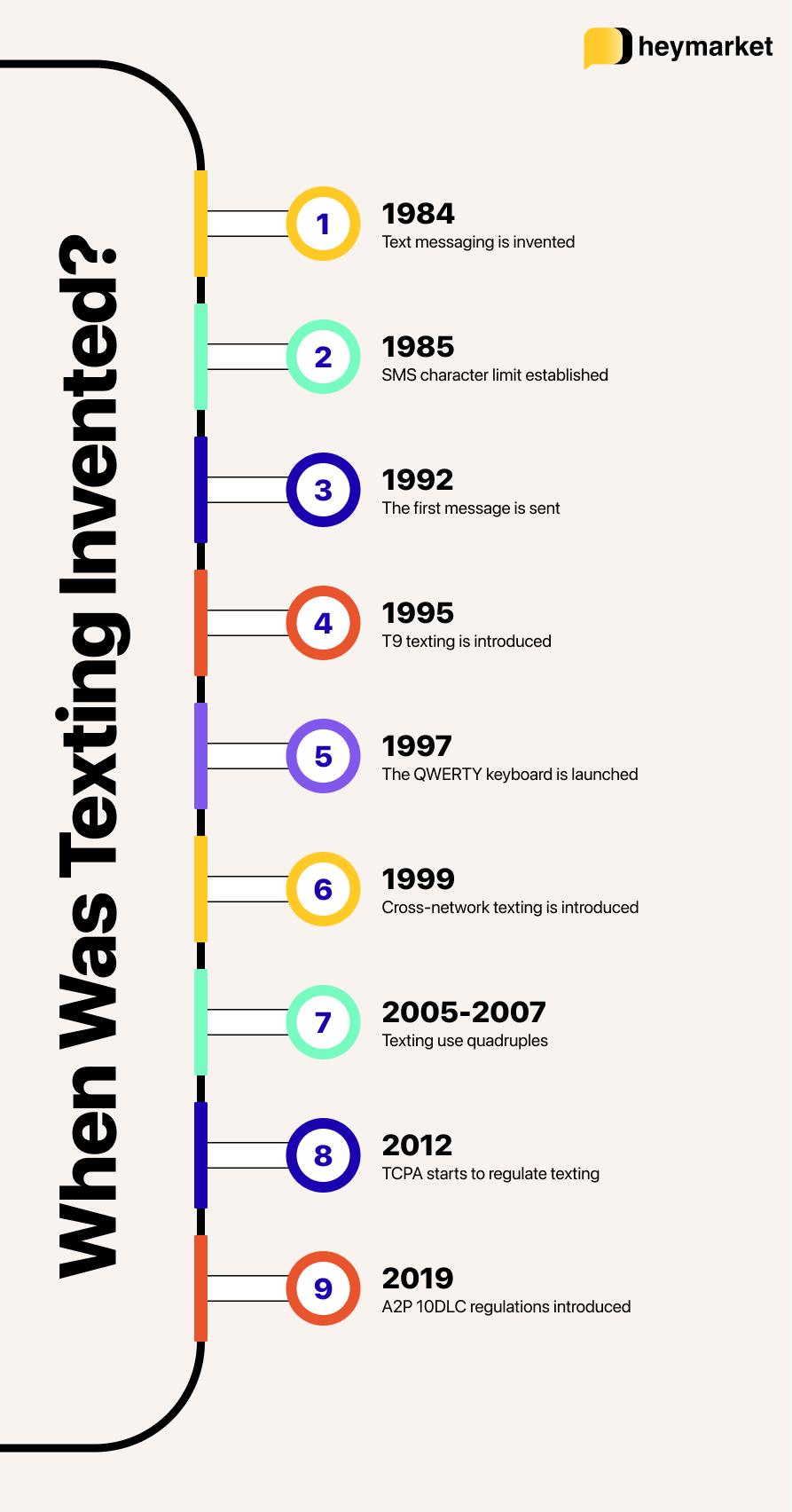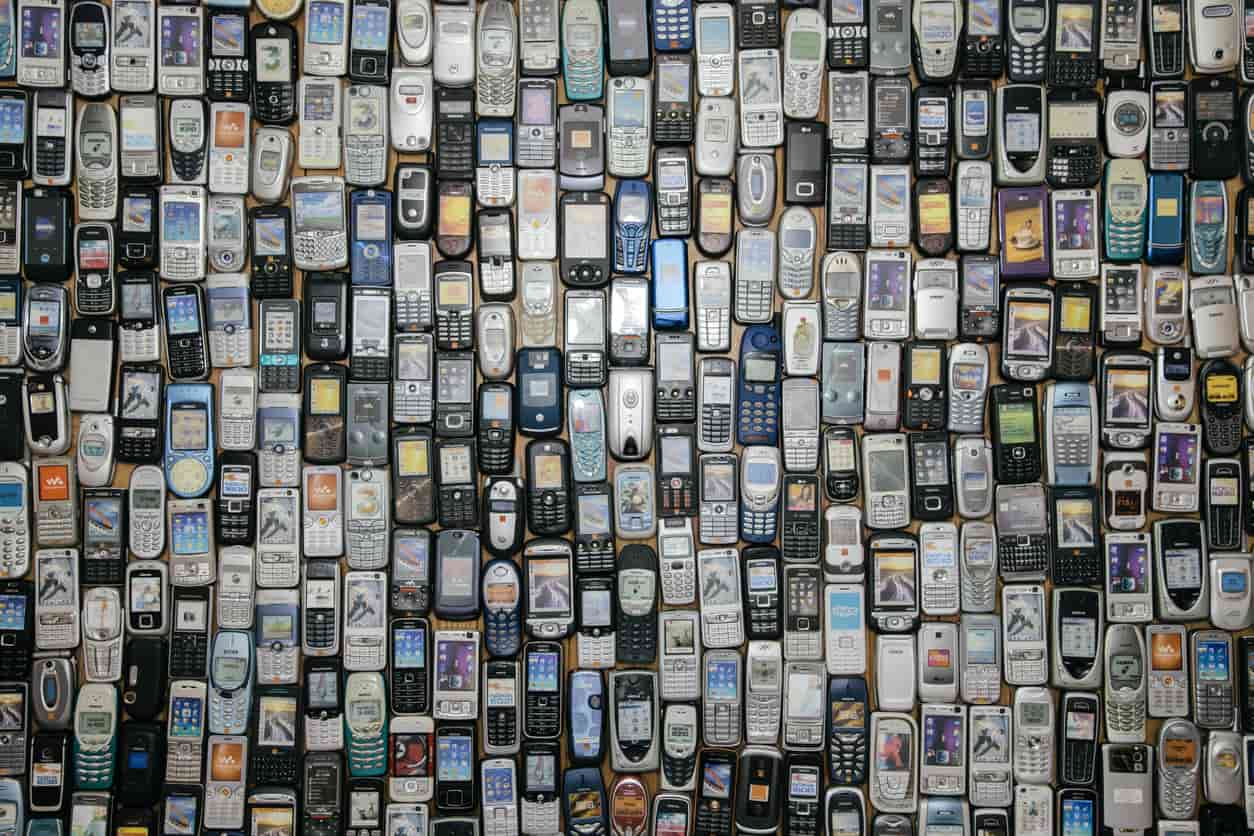Texting and text messages are so ingrained in our daily life that, for many of us, it’s probably hard to imagine a world where they didn’t exist. For others, it’s downright impossible: some millennials and members of Gen-Z have never known a world without texts.
As these generations grow up, so is their preferred communication method. Meanwhile, even older generations have become more accustomed to sending texts, making the channel America’s most popular form of communication. As mobile technology spreads throughout the world, the same story is playing out in emerging economies, where text messaging is also the most popular way that people interact digitally.
But how did we get to this point? When did texting start—and where is it headed? To better understand how we use texting today, we decided to take an in-depth look at the history of texting.

SMS research and discovery in the 1980s
1984: Text messaging is invented — but by whom?
Text messaging was invented in 1984. That much we know for a fact.
From there, the exact details become quite a bit murkier. Unlike other communications breakthroughs, texting does not have one clear, Edison-like inventor. By some accounts, the idea for the text message was first conceived by Matti Makkonen, a Finnish engineer, who has been called the “Father of SMS.” According to this version of events, Makkonen attended a telecoms industry conference in 1984, where, while talking with colleagues at a Copenhagen pizzeria, he forwarded the idea of sending text-based messages between mobile phones, rather than between pagers.
However, even Makkonen himself sought to downplay his central role in the text’s invention. Speaking to the BBC, Makkonen was quoted as saying (over text message, naturally): “I did not consider SMS as personal achievement but as result (sic.) of joint effort to collect ideas and write the specifications of the services based on them.”
Still, something like an alternative consensus has formed, which centers around two other innovators working together in 1984. Friedhelm Hillebrand and Bernard Ghillebaert, came up with the theory and protocols for the “short message service,” or SMS, while working together as part of a Franco-German cooperative Groupe Speciale Mobile, or GSM.
1985: Texting Reaches Its (Character) Limit
Although today we may think of texts as inseparable from the cell phone, these messages actually got their start elsewhere. In 1985, as the GSM researchers sought to move beyond the theoretical and lay a foundation for a standardized text messaging service, Hillebrand had an epiphany—not while on his phone, but while behind his typewriter.
Punching out a series of random sentences and questions on a sheet of paper, Hillebrand began to notice a pattern: as he typed and typed, he realized that each of the entries wound up nearly the same length. This character count—160—eventually became the upper limit on characters for SMS.
Texts take off in the ’90s
1992: The first message is sent
While these early innovations marked a breakthrough, it would still be quite some time before someone actually sent a text message. And when they finally sent it, they used a computer. On December 3, British engineer Neil Papworth sent an SMS from his computer to Vodafone’s Richard Jarvis. What was written in this very first message? “Merry Christmas.” And the reply? Well, a reply would have to wait: although Jarvis’s Orbitel 901 mobile phone allowed him to read the message, he was unable to write back since mobile phones in 1992 did not yet have keyboards.
1993: Nokia introduces SMS-friendly phones
Luckily, keyboards would begin to grow in popularity after Nokia released its first SMS-capable phones the following year. While this made life a bit easier for early texters, they were still only able to send texts to others on the same network. (Not to mention that typing out a text on a 10-number dial pad could be quite time-consuming! Which brings us to…)
1995: T9 makes typing a (relative) breeze
Just a couple years later, as text messaging was beginning to take off, T9 technology appeared and changed the game for typing speed. This technology gave texters the ability to press just a single key for each letter, this predictive text technology unlocked a whole level of typing speed and transformed how people could use their phones.
1997: Nokia debuts the 9000i Communicator, with a full QWERTY keyboard
Typing became even easier for some in 1997, when Nokia unveiled the first phone in the US with a full QWERTY keyboard. Combining easier texting with the ability to browse the web, send emails, and even edit spreadsheets, this innovative phone laid the groundwork for later (and “smarter”) touchstones from Blackberry and Apple.
1999: Cross-network texting is introduced
At last, just before the close of this revolutionary decade, texts could be sent between different networks. According to the Wall Street Journal, with this advancement, “a new fever was born.”
When Did Texting Become Popular?
2000-2007: Texting use skyrockets
Texting steadily grew in popularity over the course of the 1990s, but things really took off at the turn of the millennium with the introduction of cross-network texting. No longer limited to exchanging messages with subscribers of the same cell provider, people could now text any of their friends and colleagues, regardless of their preferred network. Illustrating the boom in texting that took place over these years, the average texts sent per month by American cell phone users grew from just 0.4 in 1995 to 35 in 2000.
The growth didn’t end there. By 2002, over 250 billion texts were sent around the world. In the US, the total number of texts sent annually nearly quadrupled from 2005 to 2007, growing from 81 billion to 363 billion. Before the end of the millennium’s first decade, texting would surpass phone calls as the most popular means of communication. In 2011, Americans sent an incredible 2.3 trillion texts.
2010 and Beyond: Business texting becomes business as usual
If texting between individuals, also known as person-to-person (P2P) messaging, took off in the 2000s, then the next decade was when businesses decided to get in on the action with application-to-person (A2P) messaging.
A2P includes everything from marketing messages and chat bots, to one-time passwords, PIN codes, and appointment reminders—all things that already seem routine today. In reality, these interactions represent the newest frontier in texting and the results of a decade full of change.
2012: Texts comes under the sway of the TCPA
Reacting to the growth of business texting, the Federal Communications Commission declared in a 2012 rule change that business text messages are subject to regulations under the Telephone Consumer Protection Act. Under the law, businesses must acquire consent from customers before engaging in text messages.
Learn more about TCPA and SMS compliance.
2017: P2P and A2P traffic are officially differentiated by carriers
Regulators aren’t the only ones who have changed how they interact with businesses sending texts. In 2017, a leading telecom industry group known as the CTIA released an updated version of its Messaging Best Practices and Guidelines. The updated guidelines officially distinguished between P2P and A2P messaging traffic for the first time.
2019: A2P definition expanded
In its next update, the CTIA clarified its definition of A2P traffic to include any “business, organization, or entity” communicating with consumers over text. This expanded definition included groups like schools and political organizations, which were not considered A2P messagers under previous guidelines.
2019-2021: A2P 10DLC regulations rolled out
This clarification was crucial because change for A2P messaging was on the way. Over the following two years, carriers introduced a series of regulations known as A2P 10DLC, short for Application-to-Person 10-Digit Long Codes, aimed at reducing spam, improving customer experience, and ensuring message deliverability for businesses. These changes required any organizations texting customers through standard 10-digit long code numbers to register their businesses with carriers by September 31, 2021. In effect, local 10-digit numbers have become the standard for business texting and can now support high-volume business text messaging.
As all of these changes have unfolded, businesses gradually unlocked and evolved a whole new channel for engagement—and it’s not just businesses that have seen the benefits along the way. Fast forward from the beginning of A2P to today, and 85% of consumers now prefer mobile messages to calls or emails.
The longer history of texting: early forms of text messages
If we only look at text messaging’s development from its rise in the mid-1980s until today, we might miss a certain truth about our favorite way to connect: the text’s history goes much further back than you might realize.
The electrical telegraph
For instance, the electrical telegraph is in many ways a forerunner of today’s text messages. Giving people the ability to send a text-based message at previously unheard of speeds, the first telegram was delivered by inventor Samuel Morse, in 1844.
Like texting, the telegraph faced early issues and slow adoption. Telegrams were only sent by a limited set of users, until advances in transmission and printing speed helped make the telegraph a wildly popular means of communicating. By 1929, over 200 million messages were sent around the world. Early “texters” even used shorthand resembling our use of “lol” and “How r u” today.
Eventually, our newer technologies made the telegram obsolete. (Western Union ended its service in 2006, just as texts began to peak.) But there can be little doubt that the technology served as a model for the inventors who dreamed up the texts we know and use today.
The telex
The telex network provided another such model. Short for “telegraph exchange,” the telex service originated in the early 1930s and soon spread throughout the world. Essentially a typewriter connected to the telephone network, the telex was considered an evolution of the telegraph system. After typing up their messages on a keyboard, telex subscribers could send their messages directly to other telex users.
By the 1980s, the telex network saw competition from the fax machine, which enabled people to send not just short text-based messages but full, digitized documents. With the emergence of text messages and emails in the 1990s, the telex network soon fell from use.
Text messaging’s bright future
From its origins in legacy technologies like the telegraph and the telex, to the rapid rise of SMS in the early twenty-first century, text-based messaging has a long and storied past. However, the texting we know today is ultimately a technology still in its infancy.
Text messaging is now the most common way for people to interact, marking a new era of communication. More than 5 billion, or about 65% percent of the world’s population, now send and receive text messages. And as texting’s popularity has risen, it’s changed how we communicate and only begun to show its potential.
However, many businesses have been slow to adapt to this sea change in how people communicate. One survey found that just 39% of businesses communicate with customers over text. Still, adoption continues to increase along with the size of the SMS market.
And as more and more businesses continue to realize texting’s many uses and benefits, they’ll continue adding to the rich history of text messaging that’s still being written.





